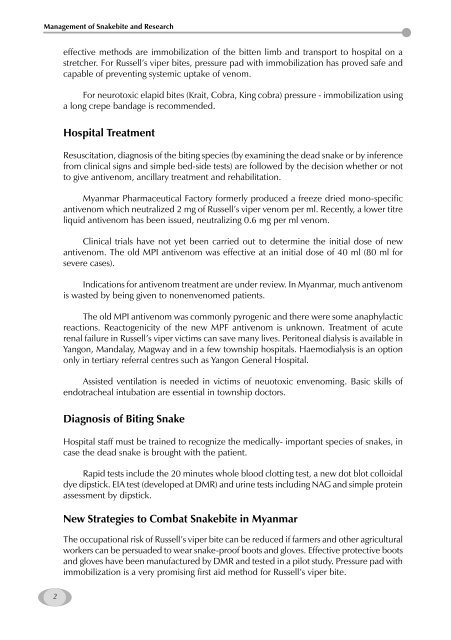Management of Snakebite and Research Management of Snakebite ...
Management of Snakebite and Research Management of Snakebite ...
Management of Snakebite and Research Management of Snakebite ...
Create successful ePaper yourself
Turn your PDF publications into a flip-book with our unique Google optimized e-Paper software.
<strong>Management</strong> <strong>of</strong> <strong>Snakebite</strong> <strong>and</strong> <strong>Research</strong><br />
2<br />
effective methods are immobilization <strong>of</strong> the bitten limb <strong>and</strong> transport to hospital on a<br />
stretcher. For Russell’s viper bites, pressure pad with immobilization has proved safe <strong>and</strong><br />
capable <strong>of</strong> preventing systemic uptake <strong>of</strong> venom.<br />
For neurotoxic elapid bites (Krait, Cobra, King cobra) pressure - immobilization using<br />
a long crepe b<strong>and</strong>age is recommended.<br />
Hospital Treatment<br />
Resuscitation, diagnosis <strong>of</strong> the biting species (by examining the dead snake or by inference<br />
from clinical signs <strong>and</strong> simple bed-side tests) are followed by the decision whether or not<br />
to give antivenom, ancillary treatment <strong>and</strong> rehabilitation.<br />
Myanmar Pharmaceutical Factory formerly produced a freeze dried mono-specific<br />
antivenom which neutralized 2 mg <strong>of</strong> Russell’s viper venom per ml. Recently, a lower titre<br />
liquid antivenom has been issued, neutralizing 0.6 mg per ml venom.<br />
Clinical trials have not yet been carried out to determine the initial dose <strong>of</strong> new<br />
antivenom. The old MPI antivenom was effective at an initial dose <strong>of</strong> 40 ml (80 ml for<br />
severe cases).<br />
Indications for antivenom treatment are under review. In Myanmar, much antivenom<br />
is wasted by being given to nonenvenomed patients.<br />
The old MPI antivenom was commonly pyrogenic <strong>and</strong> there were some anaphylactic<br />
reactions. Reactogenicity <strong>of</strong> the new MPF antivenom is unknown. Treatment <strong>of</strong> acute<br />
renal failure in Russell’s viper victims can save many lives. Peritoneal dialysis is available in<br />
Yangon, M<strong>and</strong>alay, Magway <strong>and</strong> in a few township hospitals. Haemodialysis is an option<br />
only in tertiary referral centres such as Yangon General Hospital.<br />
Assisted ventilation is needed in victims <strong>of</strong> neuotoxic envenoming. Basic skills <strong>of</strong><br />
endotracheal intubation are essential in township doctors.<br />
Diagnosis <strong>of</strong> Biting Snake<br />
Hospital staff must be trained to recognize the medically- important species <strong>of</strong> snakes, in<br />
case the dead snake is brought with the patient.<br />
Rapid tests include the 20 minutes whole blood clotting test, a new dot blot colloidal<br />
dye dipstick. EIA test (developed at DMR) <strong>and</strong> urine tests including NAG <strong>and</strong> simple protein<br />
assessment by dipstick.<br />
New Strategies to Combat <strong>Snakebite</strong> in Myanmar<br />
The occupational risk <strong>of</strong> Russell’s viper bite can be reduced if farmers <strong>and</strong> other agricultural<br />
workers can be persuaded to wear snake-pro<strong>of</strong> boots <strong>and</strong> gloves. Effective protective boots<br />
<strong>and</strong> gloves have been manufactured by DMR <strong>and</strong> tested in a pilot study. Pressure pad with<br />
immobilization is a very promising first aid method for Russell’s viper bite.









